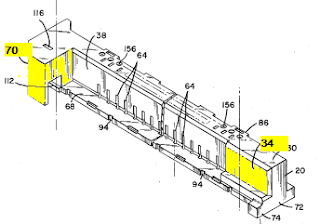Details:
In some cases, the Board considers grammar during claim construction. The claim limitation at issue in Ex parte Chen was "the bonding part having a flat surface in contact with the substrate and being formed with a vacant region." The Applicant distinguished the reference by arguing that the vacant region in the reference was not part of the flat surface. The Board found that claim 1 did not require the flat surface to have a vacant region, but instead required the bonding portion to have a flat surface and a vacant region.
Ex parte Khosravi considered which nouns/noun phrases were modified by the adjective "tubular." The claim limitation at issue was "the tubular member being expandable from a collapsed state to an expanded state." The Applicant argued that the claim requires the member to be tubular in both the expandable and the collapsed state, distinguishing over the reference which was flat rather than tubular in the collapsed state. The Examiner took the position that under the broadest interpretation, it is the member that is tubular, not the state: "a collapsed, flattened tubular member ... still has the structure of a tubular member regardless of whether it is collapsed or expanded." The Board agreed with the Examiner, finding that the adjective "tubular" modifies "member" but not either of the claimed states. The Board then affirmed the anticipation rejection.
The claim limitation at issue in Ex parte Hayman was "a layer made from a thermoplastic material or a plastic bend material in the absence of a cavity." The Applicant distinguished over the reference by arguing that the layer in the reference included a cavity, thus implicitly interpreting the limitation as "a layer ... without a cavity." The Board instead read the phrase "in the absence of a cavity" as modifying the verb "made" rather than the noun "layer." The Board then treated "in the absence of a cavity" as a product-by-process limitation. Since the Applicant did not show how the claimed layer itself differed from the layer disclosed in the references, the prior art rejection was affirmed.
In other cases, the Board uses grammatical analysis in determining whether a claim is indefinite. In Ex parte Cummings, the Examiner found claim 4 to be indefinite because it was unclear which element was modified by "provided with."
4. An assembly according to claim 1 wherein said retarding means includes a cylinder filled with a fluid and a piston having a head portion displaceable in said cylinder, provided with restricted passageways therethrough including one-way valves.The Board noted that the final phrase "might modify any one or more of the retarding means, the cylinder, the piston and the head portion." The Board found that the ambiguity significantly affected the scope of the claim, and that the specification did not resolve the ambiguity. The Board therefore affirmed the indefiniteness rejection.
Ex parte Blattner involved an application claiming priority to a Chinese application. Claim 1 was rejected as indefinite:
1. A reticle manipulating deviceThe Examiner could not determine which elements were modified by each of the clauses emphasized above. After four pages of careful parsing and analysis, and with some reference to the Applicant's specification, the Board found that the claim was not indefinite. The Board did say that the "is hereby" clause was "awkward."
with an at least substantially closed housing for maintaining clean-room conditions inside the housing,
which has several functional units,
each of which conducts at least one function for the reticle inside the housing,
wherein a first functional unit is designed as an input/output station for introducing and discharging reticles in and out of the housing,
a manipulating device also arranged inside the housing for transferring the reticles from the input/output station to the at least one other functional unit and vice versa,
is hereby characterized by an interface of the functional unit,
by means of which the at least one functional unit can be connected to the reticle manipulating device.
My two cents: The reticle manipulating device claim in Ex parte Blattner made my head hurt. But I suppose really-hard-to-parse is not the test for indefiniteness.
If it was clear that the Examiner interpreted differently than I intended because of grammar, i.e., the Examiner was parsing the claim differently than me, then I'd strongly consider amending rather than arguing.
- the tubular member being expandable from a collapsed state to an expanded state =>
the tubular member being expandable from a tubular collapsed state to a tubular expanded state
- a layer made from a thermoplastic material or a plastic bend material in the absence of a cavity =>
a layer without a cavity, the layer made from a thermoplastic material or a plastic bend material







